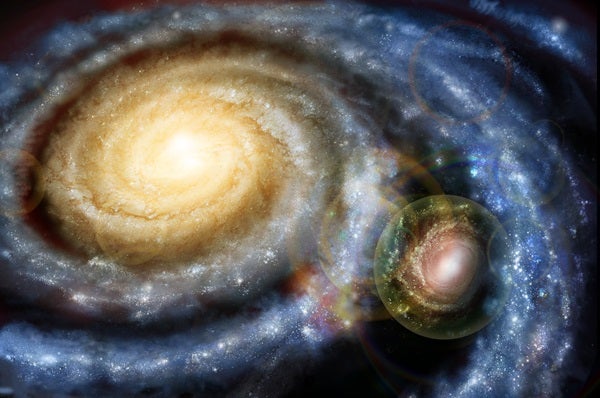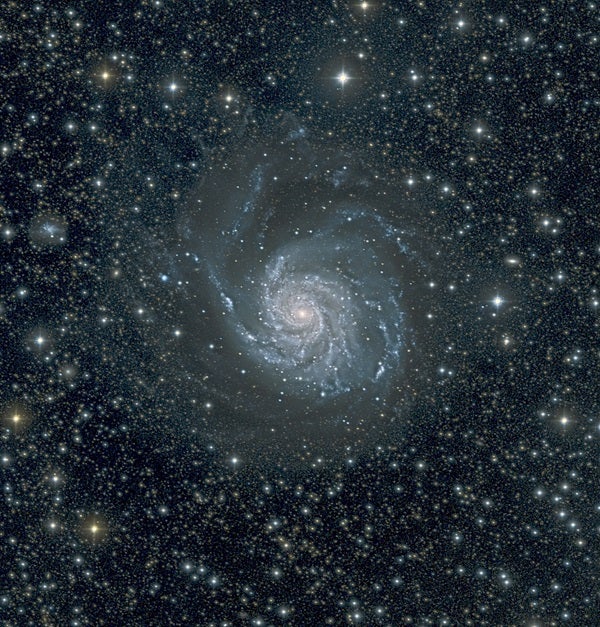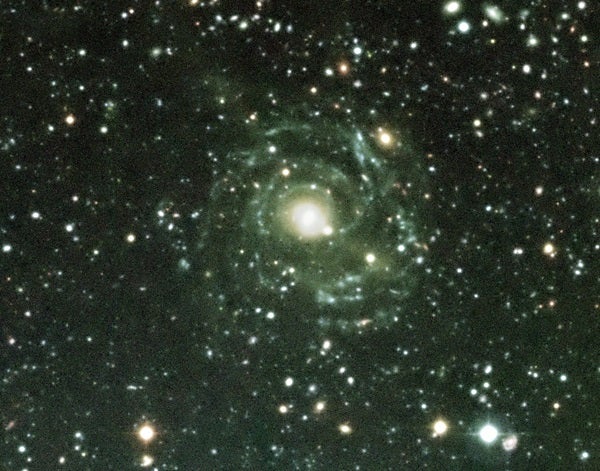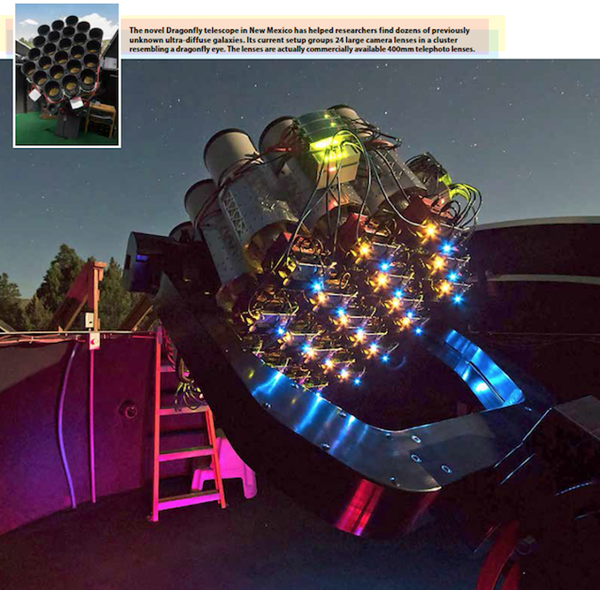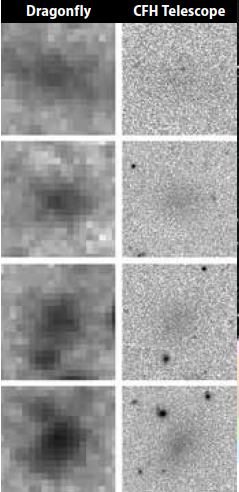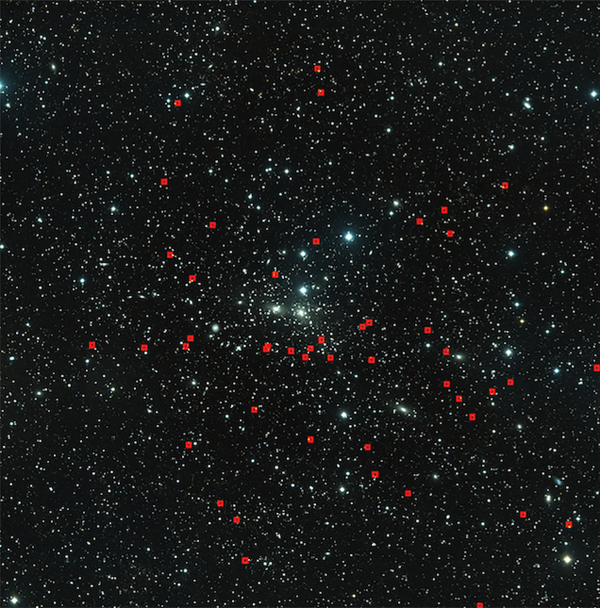Then another thought cut through the whimsy. The young Welsh astronomer realized the alien had no chance of seeing the Milky Way, let alone the universe’s oodles of dimmer galaxies. Overwhelmed by the glare of all the stars stuffed into its resident galaxy, the alien would unknowingly be blinded to most of the cosmos.
Disney wondered if we might be similarly deceived, awash in the inescapable glow of our own surroundings. “It occurred to me there could be a whole universe up there of hidden galaxies, just a little dimmer than those we can detect from Earth,” says Disney, an emeritus professor at Cardiff University in Wales.
Since that revelation in the desert nearly a half-century ago, Disney, now 80, has searched for a shadowy galactic realm. His hunch gained momentum in the 1980s and 1990s, but at the turn of the century, the trail ran cold. Disheartened and defeated, Disney relinquished the hunt.
But recently, serendipitous sightings and new technology have reinvigorated the concept of a hidden cosmos. “Most of the universe is likely undiscovered,” says Greg Bothun, an astrophysicist at the University of Oregon who has long studied faint galaxies. The emerging population of dim galaxies likely outnumbers, and is strikingly different from, the typical bright galaxies we know and love, challenging our conventional theories of galaxy formation and evolution. Dim galaxies also may solve an old mystery about missing matter in the universe.
By these reckonings, hidden galaxies are the cosmic norm, not our garish Milky Way and its ilk. Long overlooked, the dominion of dim galaxies may finally be getting its due.
Blinded By The Light
Our universe is suffused with luminous galaxies. We can see the nearest few of these great collections of stars, gas (mostly hydrogen), and dust with our eyes from Earth. Telescope surveys suggest as many as 2 trillion are out there, albeit mostly of a small, faint, “dwarf” variety. Tidily, these galactic hordes come in stereotypical shapes and sizes, such as large spirals like the Milky Way, even bigger football-shaped ellipticals and those dime-a-dozen dwarf galaxies. They follow typical life cycles, making abundant stars in their youths and slowing down as they age.
For all we’ve learned about galaxies and the wider cosmos, though, astronomers have struggled with human limitations as heavenly observers. Our instruments can only readily perceive objects whose brightness contrasts enough with the glow of the night sky. For sure, night looks dark — around 50 million times darker than day — but that’s still just relatively dark. “We live right next to this bloody luminous star called the Sun,” says Disney. “That’s always going to make it difficult for us to find this hidden universe.”
The Sun’s brilliance affects astronomical viewing in two roughly equal ways. At night, an “airglow” lingers in our atmosphere as molecules radiate away the heat they soaked up during the day. To avoid airglow, we can send instruments into orbit, like the Hubble Space Telescope (for which Disney designed instruments). But these spacecraft still must squint through the second of the Sun’s impacts, its bright illumination of icy and dusty particles around it, known as the zodiacal light. Add this to the copious light generated by all the other stars in our galaxy, and you get quite a glare. This natural “light pollution” extends to the entire electromagnetic spectrum, well beyond visible light.
“We truly are imprisoned in our lighted cell,” says Disney. “It’s like you’re in the middle of a lighted room at night and you look out the window.” Your room’s light drowns out anything less bright. In 1976, seven years after his experience in Arizona, Disney wrote in a paper in Nature that our catalogs of galaxies are probably an unrepresentative subset of the true galactic population. A great number of dimmer and potentially sizable galaxies likely awaited discovery, he proposed. Yet with little in the way of supporting data, the prophecy gained little traction.
That changed a decade later, when astronomers stumbled upon a galaxy unlike anything they’d ever seen.
A Giant Galactic Ghost
Intrigued by faint blurs on old photographic plates of the Virgo galaxy cluster, a nearby region teeming with galaxies, Bothun and colleagues wondered if the apparitions might be smallish galaxies with “low surface brightness” — astronomer-speak for emitting less light per unit area than typical galaxies.
Using Puerto Rico’s Arecibo radio telescope in 1986 to detect galactic hydrogen clouds, Bothun and colleagues uncovered a vast game changer of a galaxy a billion light-years away. Dubbed Malin 1, it’s been heavily studied ever since, and it remains the largest known spiral galaxy, seven times wider than the Milky Way with 50 times its mass. Yet, bizarrely, the galactic titan is rendered profoundly dim by its wispy spiral arms, spaced 10 times farther apart than in conventional spiral galaxies.
“It’s impossible to understand how that object exists,” says Bothun. “All our models do not produce objects anywhere near Malin 1.” The dim giant proved there might be more to the universe’s galaxies than anyone suspected.
Found and Lost
Galvanized by the discovery of Malin 1, astronomers pored over the previous decades’ photographic plates for hints of unnoticed, low-surface-brightness galaxies. (In fact, they still do — there are a lot of plates.) Although less grand than Malin 1, thousands more materialized throughout the 1990s.
Further aiding in the search were charge-coupled devices (CCDs), a far more light-sensitive imaging technology that took off in the 1980s and dominates astronomy today. “Discovering low-surface-brightness galaxies was a thrilling thing to do,” says Karen O’Neil, then a student of Bothun’s and now the director of Green Bank Observatory in West Virginia. “It’s always fun to go out and look for the unknown.”
Though intriguing, next to the billions of known luminous galaxies, these hundreds of dim ones still didn’t amount to a hill of beans, cosmically speaking. The phantom universe, so far, was just a phantom niche.
But ironically, it was work by Disney himself that ended up slamming the door shut on the field. He helped install a powerful receiver at the Parkes Observatory radio dish in Australia in 1997, hoping to wrangle many Malin 1-esque galaxies and finally blow the lid off the dim universe. In data collected over several years, more than 4,000 concentrations of hydrogen gas turned up — promising candidates as low-surface-brightness galaxies.
By 2005, however, optical telescope follow-ups on these sources suggested they were almost all just hydrogen clouds in normal galaxies. “Not one looked to be a hidden galaxy,” says Disney. The discovery was a crushing result, seeming to prove beyond doubt that Malin 1 and its ilk were just bizarre freaks, not part of a larger phantom universe.
“That killed the subject off,” says Disney. “Even I gave up.”
… And Found Again?
But the subject did not give up on him, for other skygazers thought Disney was on to something.
At a 2009 conference in the Caucasus region, Disney met Ukrainian astronomer Valentina Karachentseva, who suggested some of those thousands of hydrogen clouds in the Parkes survey were indeed galaxies. Over her career, through keen eyesight alone, Karachentseva has identified numerous dim galaxies on photographic plates. She told Disney she’d spotted standalone galaxy-like objects right where the Parkes survey had found gas clouds identified as merely extended parts of nearby bright galaxies.
Thunderstruck, Disney returned to Wales and tried something new. He went over calculations affirming just how clustered the universe’s galaxies are. They’re fundamentally social creatures, piling up practically on top of each other, leaving immense, desolate voids between clusters. Could his unseen galaxies be hidden among these huddled galactic herds, with their separate gas clouds mistaken as belonging to the closest, resplendent galactic neighbor?
Disney came to realize that the Parkes observations lacked the resolution, the fineness of detail, to make out dim galaxies tightly bunched with luminous galaxies. He tried to convince study colleagues and an astronomical journal of the possible error, but none was receptive. “I was a bit of a figure crying in the darkness,” says Disney, “literally.”
He eventually found a way to settle the matter. In early 2015 Disney was awarded time on the upgraded, exquisitely sensitive Karl G. Jansky Very Large Array (VLA) of radio dishes in New Mexico. He rescanned a sample of 19 hydrogen clouds from the 4,000 candidates in the Parkes survey. Fourteen of the clouds, it turned out, had no visible counterpart galaxy in the new data.
“Bingo,” says Disney. Straightaway, it was clear that the gas cloud radio wave sources shouldn’t have been lumped together with nearby, optically bright galaxies. He was onto something.
Hiding in Plain Sight
Disney didn’t know what these clandestine objects might be like, and he immediately wanted to follow up with new observations, which are now taking place. In late 2016, using the William Herschel Telescope in the Canary Islands, he spied hints of a dozen newfound, unmistakable dim galaxies.
These objects will increasingly have ample new company, it seems. In a 2015 study, Pieter van Dokkum of Yale University and colleagues announced they had unearthed 47 never-before-seen, Milky Way-sized yet extremely diffuse (spread out, so relatively dim) galaxies in the Coma Cluster of galaxies, among the most studied in astronomy. “This was a complete surprise,” says van Dokkum.
It was not some mammoth new telescope that sussed out these faint objects. The ever-larger telescopes the astronomical community usually clamors for are actually bad at revealing low-surface-brightness objects. These telescopes typically use mirrors, which capture more random, unwanted light, burying any faintly emitting objects. Instead, van Dokkum found his galaxies by grouping eight 400-millimeter lenses into a contraption resembling an insect’s compound eye. Indeed, the project’s name, Dragonfly, comes from van Dokkum’s hobby of taking pictures of the insect.
Dragonfly’s multiple lenses serve as checks on one another for stray light; their internal surfaces are treated with an anti-reflective coating. The lenses are hooked up to CCDs, which van Dokkum says are finally getting good enough to distinguish the universe’s mostly ghostly galaxies. “Even now,” he says, “we’re only scratching the surface.”
Traditional mirrored telescopes can still help. Inspired by van Dokkum’s find, Stony Brook University’s Jin Koda and colleagues looked through recent Coma Cluster observations from the 8.2-meter Subaru telescope in Hawaii. The researchers found 854 ultra-diffuse galaxies, with more than 300 stretching to the Milky Way’s size. This boatload had gone unnoticed because astronomers previously assumed luminous traces of the galaxies in Coma indicated small, insignificant bodies, and not just the most visible central regions of otherwise very dim objects — the tips of galactic icebergs, as it were.
The newfound dim galaxies in Coma are strange beasts, and they hark back to some of the faint galaxies first uncovered in the late 1980s. Almost entirely gasless, round and thinly stocked with old red stars, they have apparently survived for eons in a dense environment of visible galaxies. Those comparatively gas- and mass-rich conspicuous galaxies and their environs should have gravitationally pulled the inconspicuous galaxies to shreds by now — why they haven’t is a mystery.
Astronomers also are not sure how the universe made these sorts of objects in the first place. “That’s why this field is so exciting at this moment,” says Koda. “We don’t really know what these galaxies are.” They might represent a population of “failed” galaxies. Although expansive, such failure-to-launch galaxies might have started out with insufficient amounts of normal matter, or somehow lost it, stifling the formation of new stars.
Assuming that’s the case, the Coma Cluster’s population of diffuse galaxies might be the opposite of galaxies like Malin 1. Those in the latter’s class of low-surface-brightness galaxies are oddly bluish, thanks to the presence of newly made stars that are azure in color. These galaxies could be cosmic late bloomers, a kind of slowly evolving galaxy just now producing plentiful stars, billions of years after the Milky Way and others went through their peak periods of star-making. Arrested development, like in Coma, or delayed development à la Malin 1 — either way, the universe’s faint galaxies don’t mesh with conventional theory.
Dim galaxies also could force some rethinking about large-scale cosmic structure and its relation to dark matter. First theorized in the 1930s, dark matter does not emit light, betraying its existence solely through gravity. Its true identity remains a mystery, but astronomers know it outnumbers regular matter 5 to 1 and acts as gravitational glue, holding galaxies together. According to recent studies, dim galaxies like those strangely hardy ones in Coma look to be almost entirely made of the stuff. Astronomers suspect galaxies began as accumulations of dark matter in the early universe that acted as seedbeds for normal matter.
As the universe expanded, those dark matter seeds spread out into a “cosmic web,” linking galaxy clusters at the densest points with thin filaments of dark matter. If we have only seen the brightest galaxies in the universe, we don’t have the full picture about how matter and dark matter are truly distributed. “Low-surface-brightness galaxies are one of the keys to figuring out what the clumpiness of the cosmic web looks like,” says NRAO’s O’Neil. “They’ll help us understand how the universe really did grow to be what it is.”
Finally, by allowing for a more proper accounting of the matter content of the universe, dim galaxies could also help solve the long-standing “missing baryon problem.” Although few cosmologists seriously doubt that normal matter, made of particles called baryons, makes up only about 5 percent of the universe’s total mass-energy budget, the observable matter we know of is still only about half what we’d expect. “There could be a hell of a lot of stuff missing,” says Disney, “and it could be in the form of hidden galaxies.”
Increasingly, astronomers are, in a sense, seeing the dark. In July 2016, a team reported finding a humongous low-surface-brightness spiral galaxy, the first unearthed to rival Malin 1’s size. Van Dokkum, meanwhile, is expanding the Dragonfly Telephoto Array to dig up more secretive galaxies. Stony Brook’s Koda is optimistic. “There will be a lot of discoveries in the low-surface-brightness universe,” he says, “because many people are now looking into it and trying to develop new techniques to find what’s there.”
Disney, for one, thinks a huge observing campaign with the upgraded VLA in New Mexico could finally give us a handle on the true population of invisible galaxies. Some dark galaxies, like those in the Coma cluster but with even less hydrogen, will be tougher to bring into the fold. While Bothun is skeptical that human technology could ever detect the darkest of galaxies, he is confident they are out there. “The logical extension of a low-surface-brightness galaxy is a dark galaxy,” he says. “There is no reason to think they don’t exist.”
Looking back on the failed radio observations at the turn of the millennium, Disney is eager to make up for lost time and continue the search for the phantom universe’s elusive galaxies. “I was the person who did more to get things wrong than anyone,” says Disney. “I’ve just literally spent 40 years of my life on this, and I’d like to know the answer, one way or the other.”
Disney considers it a real gift that we earthlings might one day be so lucky to behold the cosmos, flooded as we are in sun- and starlight. “In such a glare,” says Disney, “it is a wonder we can do any astronomy at all.”

